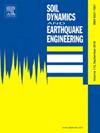通过振动台剪切箱试验研究低约束应力下砂土的动力特性
IF 4.2
2区 工程技术
Q1 ENGINEERING, GEOLOGICAL
引用次数: 0
摘要
本文提出了一项实验研究,使用放置在振动台上的等效剪切梁箱来量化砂在低约束应力水平下的动力行为,通常在1 g测试条件下遇到。得到的实验结果与已建立的分析模型的预测结果进行了系统的比较,该模型捕捉了剪切模量随相对密度和平均有效应力的增加而增加,同时也考虑了剪切强度随循环剪切应变幅值的增加而下降。随后引入了一种新的重新校准方法,通过评估整个土柱的动态响应而不是单个土元素来改进这些模型,这在低应力条件下很难进行测试。为此,在一系列砂密度和振动强度下进行了振动台试验,并计算了不同深度下的传递函数。分析表明,在低约束应力下,经验模型倾向于高估小应变砂土的刚度,同时高估剪切应变引起的模量退化,从而低估大应变砂土的刚度。重新校准的方法表明,非线性响应更少,更准确地捕捉到沙子在所有应变水平上的动态响应。本文章由计算机程序翻译,如有差异,请以英文原文为准。
Dynamic characterization of sand under low confinement stress via shear box testing on shaking table
An experimental study is presented herein, using an equivalent shear beam box placed on a shaking table to quantify the dynamic behavior of sand under low confinement stress levels, commonly encountered under 1-g testing conditions. The obtained experimental results are systematically compared with the predictions of well-established analytical models, which capture the shear modulus increase with relative density and mean effective stress while also accounting for shear strength degradation with increasing cyclic shear strain amplitude. A novel recalibration methodology is subsequently introduced to refine these models by evaluating the dynamic response of the entire soil column rather than a single soil element, which would be difficult to test under low-stress conditions. To this end, shaking table tests are conducted across a range of sand densities and shaking intensities, and transfer functions are computed at various depths. The analysis reveals that, under low confinement stresses, empirical models tend to overestimate small-strain sand stiffness, while also overestimating shear-strain-induced modulus degradation and thus underestimating large-strain stiffness. The recalibrated approach suggests a less nonlinear response, more accurately capturing the sand’s dynamic response across all strain levels.
求助全文
通过发布文献求助,成功后即可免费获取论文全文。
去求助
来源期刊

Soil Dynamics and Earthquake Engineering
工程技术-地球科学综合
CiteScore
7.50
自引率
15.00%
发文量
446
审稿时长
8 months
期刊介绍:
The journal aims to encourage and enhance the role of mechanics and other disciplines as they relate to earthquake engineering by providing opportunities for the publication of the work of applied mathematicians, engineers and other applied scientists involved in solving problems closely related to the field of earthquake engineering and geotechnical earthquake engineering.
Emphasis is placed on new concepts and techniques, but case histories will also be published if they enhance the presentation and understanding of new technical concepts.
 求助内容:
求助内容: 应助结果提醒方式:
应助结果提醒方式:


